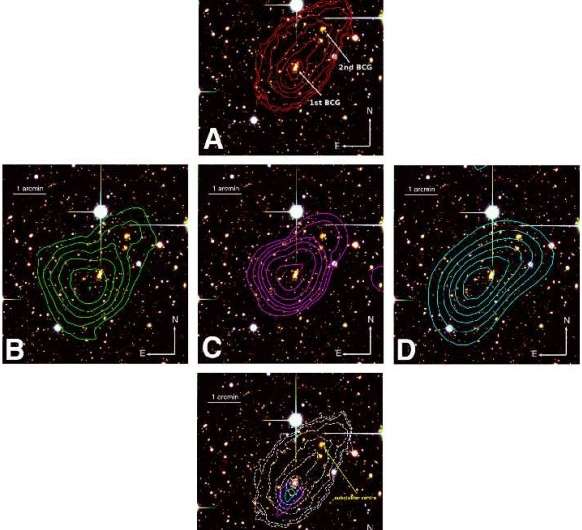November 12, 2018 report
Researchers conduct comprehensive study of the merging galaxy cluster MACS J0417.5-1154

An international team of scientists has carried out a comprehensive multi-wavelength study of one the merging galaxy clusters known as MACS J0417.5-1154. The research, available in a paper published November 1 on arXiv.org, provides new insights into the nature of this peculiar cluster.
Galaxy clusters generally form as a result of mergers and grow by accreting sub-clusters. These processes provide an excellent opportunity to study matter in conditions which cannot be explored in laboratories on Earth. In particular, merging galaxy clusters could help us better understand physics of shock and cold fronts seen in diffuse intra-cluster medium, the cosmic ray acceleration in clusters, and the self-interaction properties of dark matter.
At a redshift of 0.44, MACS J0417.5-1154 (MACS0417 for short) is a complex merging galaxy cluster hosting a steep-spectrum megaparsec-scale radio halo. It belongs to the dissociative class of mergers, where one of its substructures has had its gas content detached after the pericentric passage.
Recently, a group of researchers led by Mahadev Pandge of the Dayanand Science College in India, has decided to conduct a multi-wavelength analysis MACS0417. The scientists analyzed optical data from NASA/ESA Hubble Space Telescope and Subaru telescope in Hawaii, as well as X-ray data obtained with NASA's Chandra X-ray observatory. The study also includes radio data acquired by the Giant Metrewave Radio Telescope (GMRT) in India and observations with Caltech 10.4m Submillimeter Observatory in Hawaii at 2.1 mm wavelength.
"In this paper, we present a detailed, multi−wavelength analysis of MACS0417 by combining the existing Chandra X-ray observations with Subaru and Hubble Space Telescope optical archival observations," the researchers wrote in the paper.
The study found that MACS0417 is a very massive system, consisting of a main cluster and a subcluster, with an estimated mass of about 1.38 quadrillion solar masses. The mass of the main cluster was calculated to be approximately 1.15 quadrillion solar masses, while the subcluster turned out to be about six times less massive (196 trillion solar masses).
Optical imagery MACS0417 allowed the researchers to investigate its first brightest cluster galaxy (BCG). They found that it showcases an interesting filamentary substructure, which is atypical for normal BCGs. This could be also indicative of an ongoing merger.
The scientists underlined that MACS0417 is classified as a dissociative merger due to the fact that its main cluster has retained gaseous content. However, the study shows that the subcluster seems to have had its gas content disrupted due to the merger.
Furthermore, the research identified a surface brightness edge in MACS0417, near the location of the radio halo. The edge is located towards east-south direction, approximately 831,000 light years from the cluster's center. The researchers noted that this sharp emission edge is a cold front.
"The overall structure, surface brightness profile, temperature and metal abundance values point towards the presence of a sloshing induced cold front in this system," the paper reads.
The findings allowed the team to classify MACS0417 as one of the exceptionally rare cool-core clusters hosting an ultra steep spectrum radio halo.
More information: M.B. Pandge et al. A combined X-ray, optical and radio view of the merging galaxy cluster MACS J0417.5-1154. arXiv:1810.12071 [astro-ph.CO]. arxiv.org/abs/1810.12071
© 2018 Science X Network



















